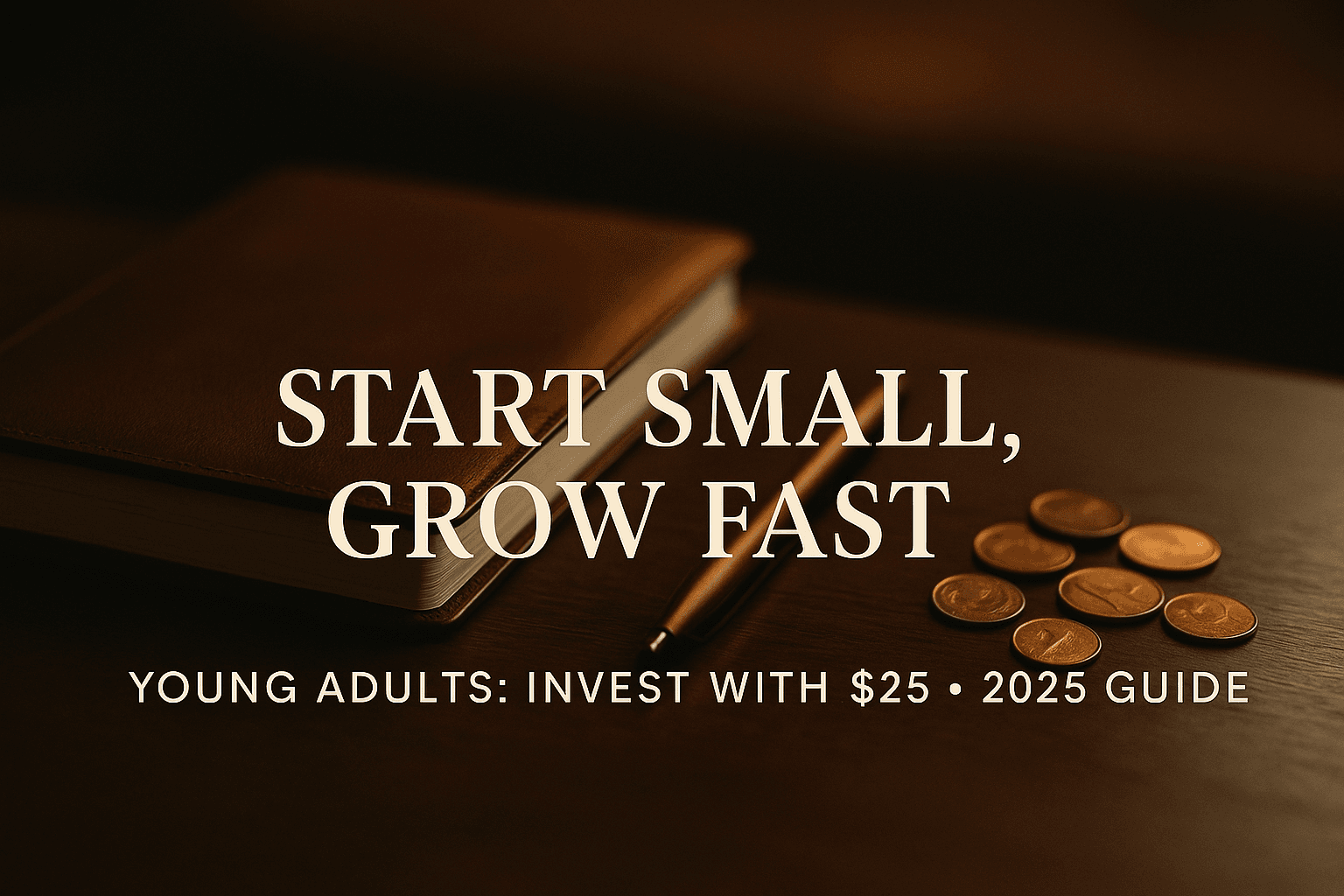Start investing with $25 — you don’t need a big salary or a finance degree to begin. With a few systems and consistency, you can build real wealth step by step.
Key Takeaways
- Start now with tiny, automatic transfers—consistency beats intensity.
- Follow a clear order of operations: budget → emergency fund → high-interest debt → investing.
- Keep investing simple: broad, low-cost index funds/ETFs + dollar-cost averaging (DCA).
- Reduce friction: automate everything and review once a week for 15 minutes.
Table of Contents
- Why “start small” wins
- The order of operations (what to do first)
- A 30-60-90 day kickstart plan
- Budget options that actually stick
- Setting up accounts globally (with examples)
- How to invest with $25–$50/week
- Sample allocations for beginners
- Fees, risk, and rebalancing
- Earning more without burning out
- Common mistakes to avoid
- FAQ
- Final checklist & CTA
How to Start Investing with $25 (Step-by-Step)
1) Why “Start Small” Wins
Waiting for the “perfect time” costs more than you think. Two reasons:
- Compounding: Even $25/week grows meaningfully over years when left invested.
- Behavior: Small, repeatable wins build confidence and momentum—your biggest asset in your 20s.
2) The Order of Operations (Do This in Sequence)
- Stabilize cash flow with a simple budget (Section 4).
- Emergency buffer: $300–$500 fast (micro-buffer), then 1 month of expenses, then aim for 3–6 months.
- High-interest debt first: Credit cards/payday loans can outpace market returns—pay them down before heavy investing.
- Invest automatically in broad, low-fee funds once steps 1–3 are rolling.
- Protect big risks: health/vehicle/renters insurance as relevant in your country.
3) 30-60-90 Day Kickstart Plan
Days 1–30
- Open a separate high-yield savings account named “Safety Net.” Move $25–$50 today and schedule $5–$10/day auto-transfer.
- Cancel/downgrade at least one subscription; negotiate one bill.
- Choose one budget framework; track two metrics only: savings rate % and total debt ↓.
- Reach $300–$500 in the Safety Net.
Days 31–60
- Pick an investing platform that supports fractional shares and low fees.
- Start DCA: invest $25–$50 each week into a broad index fund/ETF.
- Use the debt avalanche method (highest interest first) for extra payments.
- Set one micro side-hustle goal: +$100–$200 this month to feed investments.
Days 61–90
- Grow the Safety Net to one month of expenses.
- Increase weekly DCA by +1–2% of income.
- Schedule a 15-minute weekly money review (balances, wins, one tweak).
Learn more about dollar-cost averaging on Investopedia.
4) Budget Options That Actually Stick
50/30/20 Rule (simple):
- 50% Needs (rent, food, transport, minimum debt)
- 30% Wants (dining, streaming, travel)
- 20% Saving/Investing/Debt extra
Zero-Based Budget (precise):
Give every dollar a job so income minus outgo equals zero by design. Great for tight or variable income.
Pro tip: Keep one “Irregulars” category for annual/quarterly expenses (insurance, car service, gifts) to avoid surprises.
5) Setting Up Accounts Globally (Examples)
Account names vary by country—choose the tax-advantaged option first if you have access, then use a standard brokerage.
- United States: Roth IRA/401(k), then taxable brokerage.
- United Kingdom: Stocks & Shares ISA, then pension/SIPP.
- Canada: TFSA (then RRSP depending on income), then non-registered.
- Australia: Superannuation for retirement, then brokerage.
- EU/Other: Look for tax-advantaged wrappers or low-fee brokers that allow ETFs and fractional shares.
Always compare platform fees, fund expense ratios, and currency conversion costs.
6) How to Invest with $25–$50/Week
- Core Engine: a broad global or domestic market index fund/ETF (low expense ratio).
- DCA Rhythm: invest the same amount weekly/biweekly no matter the headlines.
- Automation: set contributions to run on payday; treat them like rent.
- Keep a small cash cushion in the brokerage only for upcoming buys—long-term money should stay invested.
Even if you start investing with $25 a week, automation and time will turn small habits into powerful financial momentum.
When you start investing with $25 consistently each week, small wins compound into long-term confidence and real wealth growth.
This 90-day money plan shows how anyone can start investing with $25 — even on a low income — and automate success.
Educational note: Markets fluctuate; long horizons and diversification are key. This article is not financial advice.
7) Sample Beginner Allocations (Illustrative)
Choose one that fits your risk tolerance and time horizon—rebalance annually.
- Starter Balanced: 60% global stocks / 35% bonds / 5% cash
- Young-Growth: 80% global stocks / 20% bonds
- Aggressive (long horizon, high tolerance): 90% global stocks / 10% bonds
Add a small “fun” sleeve (≤5%) for learning—individual stocks or themes—without risking your core plan.
8) Fees, Risk, and Rebalancing
- Minimize fees: Platform fees + fund expense ratios quietly eat returns. Prefer low-cost index funds/ETFs.
- Diversify widely: by geography, sector, and asset class.
- Rebalance once or twice a year, or when an allocation drifts ~5 percentage points.
- Behavior over prediction: your calendar (regular contributions) beats your feelings (timing the market).
9) Earning More Without Burning Out
Boosting income accelerates results:
- Monetize existing skills (tutoring, translation, design, coding, admin).
- Local gigs (pet sitting, events, delivery batching).
- Sell a micro-product (template, preset, guide).
Set a rule: Every extra $100 goes straight to DCA.
10) Common Mistakes to Avoid
- Waiting to “save a lump sum” before starting.
- Investing while carrying high-interest credit-card debt.
- Chasing hot tips instead of following an allocation.
- Ignoring emergency savings and insurance.
- Overtrading due to headlines or social media.

11) FAQ
Can I invest if I still have student loans?
Yes—make minimum payments, attack high-interest credit debt first, then start small DCA while paying student loans on schedule.
What if the market drops right after I start?
That’s normal. DCA buys more shares at lower prices. Stay consistent and focus on years, not weeks.
How much should I invest each month?
Whatever you can repeat. Even $25/week works. Increase by +1–2% of income every quarter.
Which is better, a robo-advisor or DIY?
Robo-advisors add convenience for a small fee; DIY can be cheaper if you stay disciplined. Pick the approach you’ll stick with.
12) Final Checklist
- Open a Safety Net account and automate $5–$10/day.
- Choose one budget system and run it for 90 days.
- Start DCA at $25–$50/week into a low-fee index fund/ETF.
- Use the debt avalanche to reduce high-interest balances.
- Book a weekly 15-minute review.
- Increase contributions by +1% next month.
Ready to take control of your money?
Start your 90-day plan today — automate your first $25 and build wealth with calm, clarity, and consistency.
👉 Join the Gabidobi Newsletter for weekly global money & mindset tips.
Ready to begin? Move your first $25 today and schedule your weekly DCA. In 90 days, you’ll have a real plan, real progress—and a portfolio that finally works for you.
- 2025 MAMA AWARDS — Complete Lineup, Categories & What’s New from Hong Kong
- 2025 K-Beauty Trends: Mirror Skin & PDRN Skincare Revolution
- Advanced Korean Skincare Routine (2025): Night & Anti-Aging Care
- Korean Skincare Layering (2025): Intermediate Routine & Hydration Tips for Glowing Skin
- Fix “Indexing Quota Exceeded” in Google Search Console (2025 Guide)
